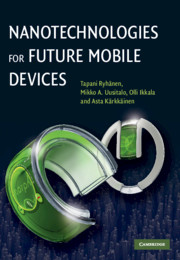Book contents
- Frontmatter
- Contents
- List of contributors
- Preface
- 1 When everything is connected
- 2 On the possible developments for the structural materials relevant for future mobile devices
- 3 Energy and power
- 4 Computing and information storage solutions
- 5 Sensing, actuation, and interaction
- 6 Future of Radio and Communication
- 7 Flat panel displays
- 8 Manufacturing and open innovation
- 9 Seeing beyond the hype: what the Internet teaches us about the development of nanotechnology
- 10 Conclusions
- Index
- References
8 - Manufacturing and open innovation
Published online by Cambridge University Press: 05 July 2014
- Frontmatter
- Contents
- List of contributors
- Preface
- 1 When everything is connected
- 2 On the possible developments for the structural materials relevant for future mobile devices
- 3 Energy and power
- 4 Computing and information storage solutions
- 5 Sensing, actuation, and interaction
- 6 Future of Radio and Communication
- 7 Flat panel displays
- 8 Manufacturing and open innovation
- 9 Seeing beyond the hype: what the Internet teaches us about the development of nanotechnology
- 10 Conclusions
- Index
- References
Summary
Introduction
This chapter discusses the changing ways by which value can be created and captured from nanotechnologies for future mobile devices. These issues are discussed from three perspectives. Firstly, attention is focused on how advanced technologies emerging from public and private laboratories can be transformed into products and services. Secondly, we look at how new, “open” models of innovation are emerging and discuss the opportunities and challenges this new approach presents for firms. Thirdly, we examine the changing ways in which manufacturing activities are coordinated and, in particular, the emergence of value creation networks as illustrated by changes in the mobile communications sector.
To allow discussion of these wide-ranging and interlinked activities, in this chapter we apply a broad definition of “manufacturing” as follows [1]:
Manufacturing is the full cycle of activity from understanding markets through design and production, to distribution and support, including after sales services and end of life management.
In this chapter, we will use the concept of the manufacturing value chain (see Figure 8.1) which allows us to consider the individual activities, the linkages between the activities, and also the manufacturing operation as a whole.
Commercialization of nanotechnologies
Commercialization of basic research outputs is typically a high-cost, long-timeframe, and high-risk activity. Such research outputs face numerous technological and market uncertainties. Basic research outputs are typified by being at a low level of “readiness” [2] but can be radical or incremental, disruptive or sustaining, and generic or specific in application.
Information
- Type
- Chapter
- Information
- Nanotechnologies for Future Mobile Devices , pp. 229 - 249Publisher: Cambridge University PressPrint publication year: 2010
